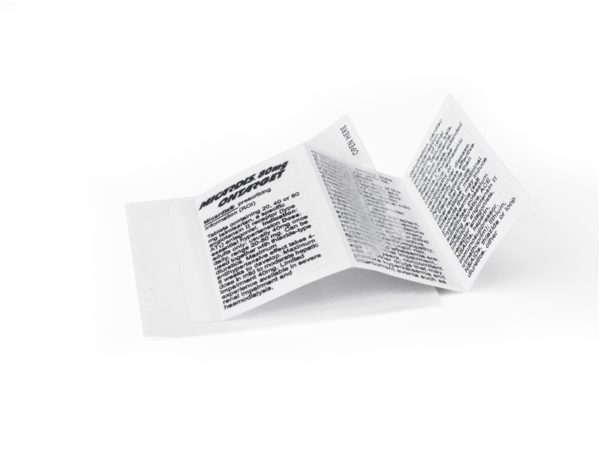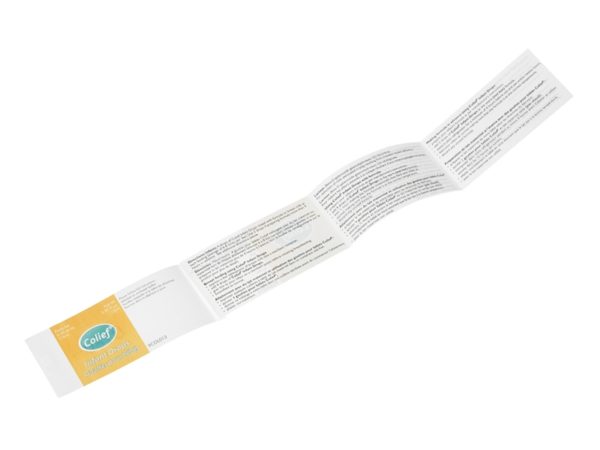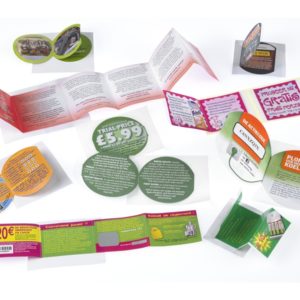Pharmaceutical Medical Booklets
Home / Full Product Range / Booklet Labels / Pharmaceutical Medical Booklets
Fully FDA certified, on a range of face papers and adhesives, these are available in concertina or booklet formats, with a range of security features.
Pharmaceutical and Medical Booklet Labels
Peel and Reseal Booklet Labels:
These labels are made for products that necessitate repeated reference to the provided information, such as dosage instructions or warnings, allowing for a peel-back feature to access information and a reseal feature to maintain product integrity.
Removable Booklet Labels:
Designed for easy removal, these labels enable patients or healthcare professionals to retain the booklet for future reference, which proves beneficial for medication instructions or equipment usage guidelines.
Repositionable Booklet Labels:
Similar to removable labels, these labels offer the flexibility of being moved and re-adhered to different surfaces without losing their adhesive properties, facilitating versatile information access.
Tactile Warning Booklet Labels:
Essential for products requiring a physical warning indicator, such as hazardous chemicals or high-potency medications, these labels incorporate tactile warning triangles to ensure safety compliance.
Track and Trace Booklet Labels:
Integral for supply chain traceability, these labels ensure authenticity and compliance with regulatory tracking requirements through integrated tracking features like barcodes or QR codes.
Tamper-Evident Booklet Labels:
Engineered for added security, these labels exhibit visible signs of tampering, providing a crucial security measure for sensitive or high-value products within the pharmaceutical industry.
Digital Booklet Labels:
Utilising digital printing technology, these labels allow for high-resolution graphics and facile content alterations, beneficial for updating regulatory information or instructions.
Concertina Booklet Labels and Expanded Booklet Labels:
Crafted to provide ample space for necessary information, instructions, and regulatory text, these labels are suitable for pharmaceutical and medical products requiring extensive labelling.
Specialty Multi-Page Labels and Multi-Layer Film Labels:
Offering multiple pages or layers for detailed information, instructions, or warnings, these labels are crucial for ensuring compliance and patient safety in the pharmaceutical and medical industries.
Yes, Braille embossed booklet labels are indeed available for pharmaceutical products. The integration of Braille on pharmaceutical labels is a crucial accessibility feature that aids visually impaired individuals in identifying and using medications safely. The European Union, for instance, mandates the inclusion of Braille on pharmaceutical packaging to ensure accessibility.
They can be customised to include essential information like medication name, dosage instructions, and expiration date, thus providing a comprehensive understanding of the product. The inclusion of Braille on pharmaceutical labels reflects a brand’s commitment to inclusivity, catering to the diverse needs of all consumers. This practice not only fosters a sense of inclusivity but also enhances consumer trust and satisfaction, positively impacting brand reputation and loyalty in the long run. Through Braille embossed booklet labels, the pharmaceutical sector takes a significant stride towards creating an accessible and inclusive environment for all individuals, irrespective of visual ability.
In the UK, pharmaceutical label regulation is overseen by the Medicines and Healthcare products Regulatory Agency (MHRA). The MHRA ensures that the labels on pharmaceutical products comply with the necessary legal and regulatory standards, providing clear, accurate, and easily understandable information to the users. This includes details such as the name of the medicine, dosage instructions, expiration date, warnings, and other crucial information that helps in the safe and effective use of the medicine.
The MHRA aligns its regulations with broader European and international standards to ensure consistency and high-quality standards in pharmaceutical labelling. The European Medicines Agency (EMA) also plays a role in setting guidelines and standards that impact pharmaceutical labelling in the UK, especially when it comes to products that are marketed across the European Union.
Pharmaceutical companies in the UK are also expected to adhere to the guidelines set out by professional bodies such as the British Pharmacopoeia Commission.
The Medicines and Healthcare products Regulatory Agency (MHRA) in the UK and the European Medicines Agency (EMA) have set outlined key requirements for pharmaceutical labels to ensure that they provide clear, accurate, and essential information to the users. Here are some of the key requirements:
Product Identification: The name of the medicine, including the brand name and/or generic name. The strength of the medicine. The form of the medicine (e.g., tablets, capsules, liquid, etc.).
Active Ingredients: The name and amount of active substance(s) per dosage unit.
Dosage Instructions: Clear instructions on how to use the medicine, including the dose, frequency, and route of administration.
Warnings and Precautions: Any necessary warnings, precautions, and information on potential side effects.
Other details include storage instructions, expiry date, batch number, manufacturer information, contact information and a leaflet providing further detailed information about the medicine.
They are applied to folding boxes, outer packaging, vials, containers with small radii, and infusion bottles for essential information display. They are also found on syringes, pens, autoinjectors, and blisters to aid in identification and provide usage instructions. Additionally, they are used on plastic containers and specially shaped packages like inhalers to ensure correct usage and adherence to regulatory standards.
Booklet labels are commonly used on pharmaceutical products due to their ability to show extensive information in a compact, organised manner. They provide ample space for the mandatory details such as dosage instructions, warnings, and multilingual information (which is crucial for global distribution). Additionally, they aid in compliance with regulatory requirements, ensuring that all necessary data is readily accessible to users.
Fully FDA certified, on a range of face papers and adhesives, these are available in concertina or booklet formats, with a range of security features.
Pharmaceutical and Medical Booklet Labels
Peel and Reseal Booklet Labels:
These labels are made for products that necessitate repeated reference to the provided information, such as dosage instructions or warnings, allowing for a peel-back feature to access information and a reseal feature to maintain product integrity.
Removable Booklet Labels:
Designed for easy removal, these labels enable patients or healthcare professionals to retain the booklet for future reference, which proves beneficial for medication instructions or equipment usage guidelines.
Repositionable Booklet Labels:
Similar to removable labels, these labels offer the flexibility of being moved and re-adhered to different surfaces without losing their adhesive properties, facilitating versatile information access.
Tactile Warning Booklet Labels:
Essential for products requiring a physical warning indicator, such as hazardous chemicals or high-potency medications, these labels incorporate tactile warning triangles to ensure safety compliance.
Track and Trace Booklet Labels:
Integral for supply chain traceability, these labels ensure authenticity and compliance with regulatory tracking requirements through integrated tracking features like barcodes or QR codes.
Tamper-Evident Booklet Labels:
Engineered for added security, these labels exhibit visible signs of tampering, providing a crucial security measure for sensitive or high-value products within the pharmaceutical industry.
Digital Booklet Labels:
Utilising digital printing technology, these labels allow for high-resolution graphics and facile content alterations, beneficial for updating regulatory information or instructions.
Concertina Booklet Labels and Expanded Booklet Labels:
Crafted to provide ample space for necessary information, instructions, and regulatory text, these labels are suitable for pharmaceutical and medical products requiring extensive labelling.
Specialty Multi-Page Labels and Multi-Layer Film Labels:
Offering multiple pages or layers for detailed information, instructions, or warnings, these labels are crucial for ensuring compliance and patient safety in the pharmaceutical and medical industries.
Yes, Braille embossed booklet labels are indeed available for pharmaceutical products. The integration of Braille on pharmaceutical labels is a crucial accessibility feature that aids visually impaired individuals in identifying and using medications safely. The European Union, for instance, mandates the inclusion of Braille on pharmaceutical packaging to ensure accessibility.
They can be customised to include essential information like medication name, dosage instructions, and expiration date, thus providing a comprehensive understanding of the product. The inclusion of Braille on pharmaceutical labels reflects a brand’s commitment to inclusivity, catering to the diverse needs of all consumers. This practice not only fosters a sense of inclusivity but also enhances consumer trust and satisfaction, positively impacting brand reputation and loyalty in the long run. Through Braille embossed booklet labels, the pharmaceutical sector takes a significant stride towards creating an accessible and inclusive environment for all individuals, irrespective of visual ability.
In the UK, pharmaceutical label regulation is overseen by the Medicines and Healthcare products Regulatory Agency (MHRA). The MHRA ensures that the labels on pharmaceutical products comply with the necessary legal and regulatory standards, providing clear, accurate, and easily understandable information to the users. This includes details such as the name of the medicine, dosage instructions, expiration date, warnings, and other crucial information that helps in the safe and effective use of the medicine.
The MHRA aligns its regulations with broader European and international standards to ensure consistency and high-quality standards in pharmaceutical labelling. The European Medicines Agency (EMA) also plays a role in setting guidelines and standards that impact pharmaceutical labelling in the UK, especially when it comes to products that are marketed across the European Union.
Pharmaceutical companies in the UK are also expected to adhere to the guidelines set out by professional bodies such as the British Pharmacopoeia Commission.
The Medicines and Healthcare products Regulatory Agency (MHRA) in the UK and the European Medicines Agency (EMA) have set outlined key requirements for pharmaceutical labels to ensure that they provide clear, accurate, and essential information to the users. Here are some of the key requirements:
Product Identification: The name of the medicine, including the brand name and/or generic name. The strength of the medicine. The form of the medicine (e.g., tablets, capsules, liquid, etc.).
Active Ingredients: The name and amount of active substance(s) per dosage unit.
Dosage Instructions: Clear instructions on how to use the medicine, including the dose, frequency, and route of administration.
Warnings and Precautions: Any necessary warnings, precautions, and information on potential side effects.
Other details include storage instructions, expiry date, batch number, manufacturer information, contact information and a leaflet providing further detailed information about the medicine.
They are applied to folding boxes, outer packaging, vials, containers with small radii, and infusion bottles for essential information display. They are also found on syringes, pens, autoinjectors, and blisters to aid in identification and provide usage instructions. Additionally, they are used on plastic containers and specially shaped packages like inhalers to ensure correct usage and adherence to regulatory standards.
Booklet labels are commonly used on pharmaceutical products due to their ability to show extensive information in a compact, organised manner. They provide ample space for the mandatory details such as dosage instructions, warnings, and multilingual information (which is crucial for global distribution). Additionally, they aid in compliance with regulatory requirements, ensuring that all necessary data is readily accessible to users.






















